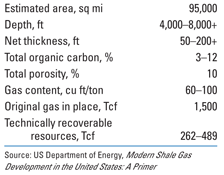Developing US Shale Plays: Marcellus—Marcellus development shows the seeds of a new gas paradigm
Marcellus development shows the seeds of a new gas paradigm Stephen Bull, Commercial Leader, Statoil ASA In November 2008, Statoil and Chesapeake Energy Corporation announced their $3.375 billion strategic
Stephen Bull, Commercial Leader, Statoil ASAIn November 2008, Statoil and Chesapeake Energy Corporation announced their $3.375 billion strategic alliance whereby Statoil acquired 32.5% of Chesapeake’s 1.8 million acres in the Marcellus fairway. In addition, the partners formed an international study group to assess shale gas opportunities outside of North America. Statoil’s acreage in the Marcellus covers approximately 600,000 acres, with estimated resources of 2.5–3.0 billion barrels of oil equivalent (boe). Activity levels in the US shale gas business have been intense, with the Marcellus attracting most of the attention over the past year. Since 2008, major US shale gas deals have been reported from Plains E&P (with Chesapeake in the Haynesville), BP (with Chesapeake in the Woodford and Fayetteville), ExxonMobil (which acquired XTO), Eni (with Quicksilver in the Barnett), BG (with Exco in the Haynesville), Total (with Chesapeake in the Barnett) and Mitsui (with Anadarko in the Marcellus). These big-ticket deals do not fully reflect the huge amount of land acquisition and divestment activity occurring within these plays. The US shale gas business is highly attractive and distinctly unconsolidated, implying that the list of new entrants and new business models will increase in the future. What are the drivers behind these heightened levels of activity? Basically, there are two. First, shale gas may represent a new natural gas supply paradigm—at first for North America, but perhaps eventually for the world, as shale gas projects outside of North America begin development. For the majors, this paradigm shift requires the acquisition of not only long-life resources, but also shale gas expertise as a “must have” skill set for global applications. It’s not the end of LNG as we know it, but shale gas is a serious challenger. Second, US natural gas drilling activity is tackling low gas prices as the free market does best, by laying down rigs in high-cost producing areas and shifting activity toward the plays with the lowest costs. This is what makes shale gas plays, and the Marcellus in particular, so favorable in the current environment. It was said best in a recent Wood Mackenzie report on US unconventional gas: “The Marcellus is now the top-ranked play on both break-even and total resource potential.” To understand deal activity in the US shale gas plays, it is useful to put these deals in context. When deciding on a particular entry strategy, companies will typically assess the relationship between the industry strategic drivers and the stage of development of a particular shale play. This is an interactive process. The development phases for shale gas plays can be broken down into four key stages: early moves and land grabs; experimentation and growth; core development; and exploitation and optimization. The Eagle Ford Shale is in the “early moves” phase, while the Barnett Shale is in both the “core development” phase and the “exploitation and optimization” phase. The Marcellus, meanwhile, is caught between continual land grabs, experimentation and some core development—simply because the size of the play is so great. It is now 16 months into the life of Statoil’s Marcellus alliance with Chesapeake, and we are very happy with the operational results and with our partner. The well results to date are very promising, and exceed our initial expectations. Well costs are falling, while, at the same time, the operator is drilling longer laterals, thereby getting more reserves per well. New rigs will be added throughout 2010 with a plan to average approximately 32 operated rigs for the year. Statoil is also continually acquiring acreage together with Chesapeake. The partnership’s Marcellus Shale holdings have the clear potential to become a long-life asset in what could be one of the world’s largest natural gas plays. We were also very pleased to confirm our equity production target of 50,000 boepd in 2012 at our recent Strategy Update presentation to the capital markets. The entry choices into the US shale gas play are varied, including speculative land grabs, financial investments, private equity participation, joint ventures and all-out corporate deals. The unconsolidated nature of the US shale business can be explained by low entry and exit barriers and the rapid application of transferable technologies. Statoil’s own strategic decision to enter the Marcellus play through alliance with Chesapeake, rather than through a direct financial investment or a full corporate deal, was more aligned with the company’s strategy and its Scandinavian culture of cooperation and partnerships. As a result of the Marcellus entry, Statoil has created a new organizational unit, Global Unconventional Gas (GUG), guided by a new business model. For Statoil, the Marcellus is not just a potentially world-class asset, but also our laboratory and our analog for building and transferring shale gas experience into new basins. Replicating and adapting our Marcellus Shale experience internationally will require unconventional thinking for both technological and commercial solutions. It took 25 years for the US to get to the level that it has reached today with regard to production of shale gas, whereas the rest of the world is just beginning this journey. Success, therefore, requires a long-term view and a commitment to the application of technology and innovative commercial solutions.
|
|||||||||||||||||||||
- Shale technology: Bayesian variable pressure decline-curve analysis for shale gas wells (March 2024)
- Prices and governmental policies combine to stymie Canadian upstream growth (February 2024)
- U.S. producing gas wells increase despite low prices (February 2024)
- U.S. drilling: More of the same expected (February 2024)
- U.S. oil and natural gas production hits record highs (February 2024)
- U.S. upstream muddles along, with an eye toward 2024 (September 2023)




